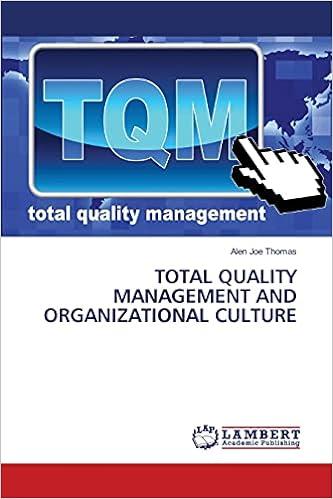Question
Wright, Inc. produces three products. Data concerning the selling prices and unit costs of the three products appear below: Product C D E Selling price
|
Wright, Inc. produces three products. Data concerning the selling prices and unit costs of the three products appear below: |
| Product | |||||||||
| C | D | E | |||||||
| Selling price | $ | 90 | $ | 70 | $ | 100 | |||
| Variable costs | $ | 65 | $ | 55 | $ | 70 | |||
| Fixed costs | 30 | 7 | 27 | ||||||
| Tapping machine time (minutes) | 20 | 6 | 6 | ||||||
| Fixed costs are applied to the products on the basis of direct labor hours. Demand for the three products exceeds the company's productive capacity. The tapping machine is the constraint, with only 2,800 minutes of tapping machine time available this week. |
| Required: | |
| a-1. | Calculate the contribution margin per minute for all three products. (Round your answers to 2 decimal places. Omit the "$" sign in your response.) |
| C | D | E | |
| Contribution margin per minute | $ | $ | $ |
| a-2. | Given the tapping machine constraint, which product should be emphasized? Support your answer with appropriate calculations. c d or e? | ||||||
|
|
| b. | Assuming that there is still unfilled demand for the product that the company should emphasize in part (a) above, up to how much should the company be willing to pay for an additional hour of tapping machine time? (Omit the "$" sign in your response.) |
| Maximum amount | $ per hour |
,,,,,,,,,,,,,,,,,,,,,,,,,,,,,,,,,,,,,,,,,,,,,,,,,,,,,,,,,,,,,,,,,,,,,,,,,,,,,,,,,,,,,,,,,,,,,,,,,,,,,,,,,,,,,,,,,,,,,,,,,,,,,,,,,,,,,,,,,,,,,,,,,,,,,,,,,,,,,,,,,,,,,,,,,,,,,,,,,
| (Prepared from a situation suggested by Professor John W. Hardy.) Lone Star Meat Packers is a major processor of beef and other meat products. The company has a large amount of T-bone steak on hand, and it is trying to decide whether to sell the T-bone steaks as they are initially cut or to process them further into filet mignon and the New York cut. |
| If the T-bone steaks are sold as initially cut, the company figures that a 1-pound T-bone steak would yield the following profit: |
| Selling price ($2.20 per pound) | $ | 2.20 |
| Less joint costs incurred up to the split-off point where T-bone steak can be identified as a separate product | 1.35 | |
| Profit per pound | $ | 0.85 |
| As mentioned above, instead of being sold as initially cut, the T-bone steaks could be further processed into filet mignon and New York cut steaks. Cutting one side of a T-bone steak provides the filet mignon, and cutting the other side provides the New York cut. One 16-ounce T-bone steak cut in this way will yield one 6-ounce filet mignon and one 8-ounce New York cut; the remaining ounces are waste. The cost of processing the T-bone steaks into these cuts is $0.17 per pound. The filet mignon can be sold for $3.60 per pound, and the New York cut can be sold for $3.40 per pound. |
| Required: |
| 1. | Determine the profit per pound from processing the T-bone steaks into filet mignon and New York cut steaks. (Do not round intermediate calculations. Round your answers to 2 decimal places.) | |||||||||||||||||||||
|
Step by Step Solution
There are 3 Steps involved in it
Step: 1

Get Instant Access to Expert-Tailored Solutions
See step-by-step solutions with expert insights and AI powered tools for academic success
Step: 2

Step: 3

Ace Your Homework with AI
Get the answers you need in no time with our AI-driven, step-by-step assistance
Get Started


